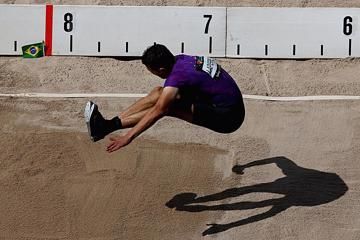Fabrice Lapierre in the long jump at the IAAF World Indoor Championships Portland 2016 (© AFP / Getty Images)
“It was my experience that helped me to stay calm and jump 8.25m in the third round and stay in the competition,” Fabrice Lapierre said about his performance at the IAAF World Indoor Championships Portland 2016.
“Then I knew I was going for a medal.”
The 32-year-old, one of the most seasoned competitors in the field, had already been crowned the world indoor champion once in his career, in 2010 in Doha. But the silver from Portland wasn’t a step back; it was more like two steps forward after a challenging period in Lapierre’s career. With his place now confirmed on the Australian Olympic team for Rio, Lapierre feels ready to return to the top of the podium.
His first international success came back in 2002, at the IAAF World Junior Championships in Kingston, where he placed second with a personal best of 7.74m. The following year he moved to the USA to study at Texas A&M University and went on to win the 2005 NCAA title with a wind-assisted 8.15m.
In 2006 he finished second at the NCAA Championships, both indoors and out. In the middle of his a busy indoor collegiate season, he flew back to Australia – 17 hours each way – to win his first national title, and then made the same trip in late March that year for the Commonwealth Games, where he took the bronze medal.
“My best years were probably 2009 and 2010,” says Lapierre. During those two seasons, he won the 2009 IAAF World Athletics Final, finished fourth on his World Championships debut in Berlin and won gold at the 2010 Commonwealth Games and IAAF World Indoor Championships.
“I didn’t even like indoors at first, at all,” Lapierre said with a laugh in Portland. “But I guess I’m getting good at it now.”
The 2010 season was also when Lapierre produced some of his biggest jumps. At the Australian Championships in Perth that year, he unleashed a massive – albeit wind-aided – jump of 8.78m (3.1m/s). It was the longest jump in any conditions since Ivan Pedroso’s 8.96m in 1995.
But despite the boost of confidence from his huge jump, nothing went according to plan for Lapierre during the few years that followed. He didn’t make it to the final at the 2011 IAAF World Championships in Daegu and, after an injury setback, didn’t qualify for the London 2012 Olympic Games.
“That was the period when I was struggling with injuries,” said Lapierre. “I somewhat lost the interest in the sport. One year I didn’t even have a coach, so I was kind of on my own. I was just going through the motions at training.”
Lapierre never quit, though, during those difficult years. He continued to make regular appearances on the international circuit and regularly jumped near to – and often beyond – the eight-metre mark. He even pulled off a fourth-place finish at the 2014 Commonwealth Games without much consistent training.
“At that point, something had to change,” he said. “I realised that I could still accomplish my biggest goal, an Olympic medal, so I decided that in 2015 and 2016, I would give it 100%.”
Lapierre knew that in order to achieve his goals, he had to return to a professional environment with a good coach and support system. That’s when he decided to move to Altis, the high-performance centre in Phoenix, to be coached by Dan Pfaff.
“[Pfaff] told me what I was doing wrong and in a way I felt like I was doing everything wrong,” Lapierre told Australian media. “But he got me back on track and changed my life and I fell back in love with the sport which was a major issue for me. I wake up every morning with a purpose, I tick all the boxes and I can’t wait to go training.”
On a technical level, Lapierre has been working on improving his speed and perfecting his take-off angle. He has also benefitted from working alongside training partners such as world and Olympic champion Greg Rutherford and Olympic silver medallist Mitchell Watt, a fellow Australian.
Watt’s story was somewhat similar to Lapierre’s. Having struggled with achilles problems, Watt found he was lacking motivation and yearning for a change of environment.
“The Australians will definitely be back and ready for Rio,” says Lapierre. “Me, Mitchell, and Henry Frayne, who is training back home. Hopefully, we all can make the team and then make it to the Olympic final.”
The change in environment seems to be working for Lapierre. In his first season with Pfaff, he captured the silver medal at the IAAF World Championships Beijing 2015 with 8.24m, his best jump for two years.
“Last season meant a lot to me, to show that the progress was there,” he said. “I’ve jumped farther before, but it was my first World Championships medal ever.”
Seven months later in Portland he earned another silver medal, setting an Oceanian indoor record of 8.25m and bettering the mark he set en route to winning the world indoor title in 2010. And just two weeks later, Lapierre officially punched his ticket to the Olympics when jumping 8.27m for the win at the Australian Championships.
“I believe that if I do everything right, if I do what I can do out there, I definitely have a shot at an Olympic medal,” he said. “It’s the only medal I don’t have.”
Elena Dyachkova for the IAAF





